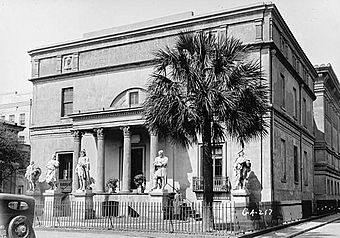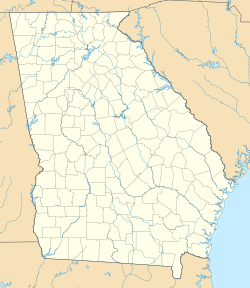Savannah Historic District (Savannah, Georgia) facts for kids
|
Savannah Historic District
|
|

|
|
| Location | Bounded by E. Broad St, Gwinnett St, and Martin Luther King Jr. Blvd. and the Savannah River, Savannah, Georgia |
|---|---|
| Area | ca. 1,300 acres (5.3 km2) |
| Architect | Multiple |
| Architectural style | Mid 19th Century Revival, Federal |
| NRHP reference No. | 66000277 |
Quick facts for kids Significant dates |
|
| Added to NRHP | November 13, 1966 |
| Designated NHLD | November 13, 1966 |
The Savannah Historic District is a big, special area in Savannah, Georgia. It covers most of the city as it was before the American Civil War. This district was named a National Historic Landmark in 1966. It is one of the largest areas in the United States that works to protect its history.
This district is famous because of the Oglethorpe Plan. This was a special way of planning a city. It was started by James Oglethorpe when Savannah was founded. This plan helped the city grow for its first 100 years.
Contents
How Savannah Was Planned
The old parts of Savannah were planned using a system of "wards." James Oglethorpe created these wards. Each ward had a central square. Around this square were four "trust lots" and four "tythings."
Trust lots were used for public buildings. These could be schools, government offices, churches, or museums. Tythings were divided into ten smaller lots for homes. The wards were set up in a straight grid. They lined up with north-south and east-west directions.
In a typical ward, the trust lots were to the east and west of the square. The home lots of the tythings were to the north and south. Each tything was split into two rows of five lots. Small alleys separated these rows. In the early days, this ward system also helped with defense. People in each ward were part of a militia. The central squares were places where people could gather if there was danger.
Exploring Savannah's Famous Places
Every year, many people visit the Savannah Historic District. They come to see its beautiful buildings. These buildings were built in the 1700s and 1800s. Visitors also enjoy the many green spaces.
The district has many important spots:
- The birthplace of Juliette Gordon Low. She started the Girl Scouts of the United States of America.
- The Telfair Academy of Arts and Sciences. This was one of the first public museums in the southern United States.
- The First African Baptist Church. This is the oldest African American Baptist church in the country.
- Temple Mickve Israel. This is the third-oldest Jewish synagogue in America.
- The Central of Georgia Railway roundhouse complex. This is the oldest train facility still standing from before the Civil War.
- Christ Church. This church is known as the "Mother Church of Georgia."
- The old Colonial Cemetery.
- The Cathedral of St. John the Baptist.
- The Old Harbor Light.
Along the waterfront, you can see Factor's Row. These used to be warehouses for cotton. Some were even built using stones that came from ships.
Other Notable Buildings and Green Spaces
Many other interesting buildings are in the district. These include:
- The Isaiah Davenport House
- The Green-Meldrim House
- The Owens-Thomas House
- The William Scarbrough House
- The Sorrel-Weed House
- The United States Customhouse
The district also has lovely green spaces. There are 22 shaded squares throughout Savannah. Forsyth Park is a large, 30-acre park at the southern edge of the district. Emmet Park is another green space near the riverfront.
Gallery



